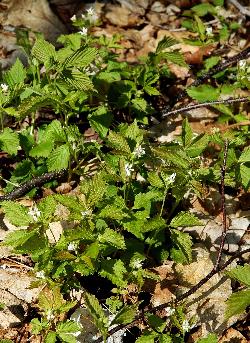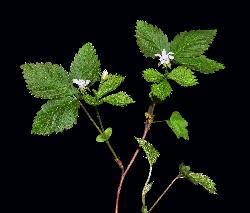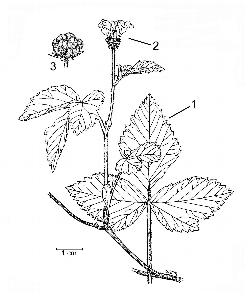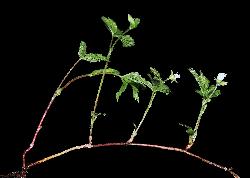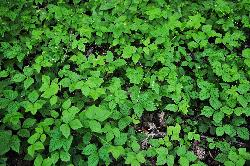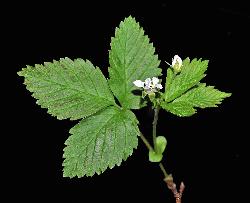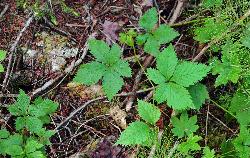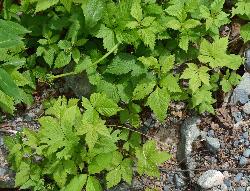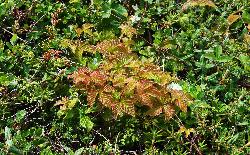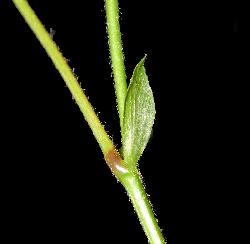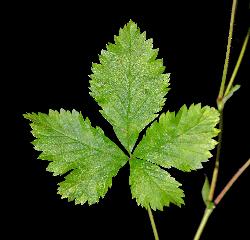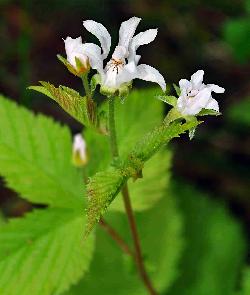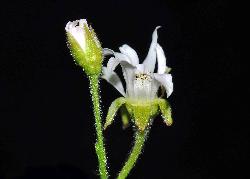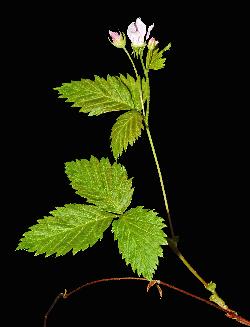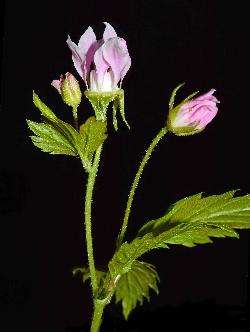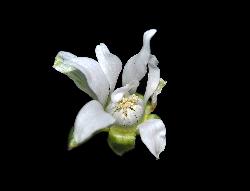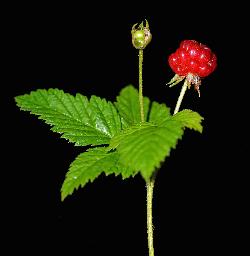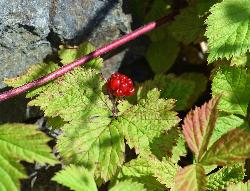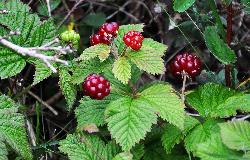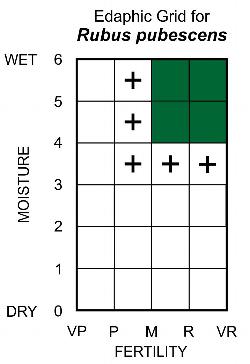Fr: ronce pubescente, catherinettes
IA: anikutshaumin, anikutshauminanakashi
Rosaceae - Rose Family
Note: Numbers provided in square brackets in the text refer to the image presented above; image numbers are displayed to the lower left of each image.
General: A low perennial subshrub with trailing slightly woody stems and erect herbaceous flowering shoots [1–3], 1–4 dm tall, with compound leaves. Dewberry is a shade-tolerant understorey species, common in rich moist forest sites and can reproduce vegetatively or by seed; however, the seed is viable for a very short time and seedlings seldom penetrated the layer of leaf litter (Whitney 1978). The plants may provide cover for small mammals, while the fruit provide food for mammals and birds (Whitney 1978). Although also called dwarf raspberry, the aggregate fruits of dewberry do not separate easily from the receptacle, a characteristic trait of true raspberries.
Key Features: (numbers 1–3 refer to the illustration [4]:
1. Leaves have 3 leaflets; the terminal leaflet is usually diamond shaped (rhomboidal) or elliptic and widest at the middle, to obovate and widest just above the middle.
2. Calyx lobes are reflexed; petals are white to pale pink and erect.
3. The fruit is an aggregate of small dark red drupelets, separating easily from the receptacle.
Stems: The slightly woody trailing stems (primocanes) are slender, reddish-brown, unarmed, and slightly pubescent [5–6]; the stems creep along the surface of the ground, often rooting at the nodes, and end in whip-like rooting tips [2, 7]. The erect herbaceous flowering shoots (floricanes) are 1–4 dm tall, finely pubescent, and bear short stipitate glandular hairs.
Leaves: Erect herbaceous shoots bear 2–5 alternate, deciduous, compound leaves, 2–7 cm long, usually with 3 leaflets (trifoliolate) [8]; vegetative shoots occasionally palmately compound, with 5 leaflets [9–10]. Young leaflets are often tinged with red, especially when growing in open sunny locations, and plicate along the veins [11]; mature leaflets are yellow-green to dark green [8–10], membranaceous, and flat. Leaves are petiolate and bear a pair of stipules at the base [3, 12]; stipules are oblanceolate, 8–12 mm long, with acute to rounded apices. Leaflets are glabrous and dull on the upper surface, while the lower surface is sparsely pubescent. The terminal leaflet is typically diamond-shaped (rhomboidal), but may be elliptic to obovate [13], 4–10 cm long by 1–4.5 cm wide, with a short stalk (petiolule), 2–7 mm long, a cuneate base, and an acute apex. Lateral leaflets are sessile, ovate, asymmetric, and broadly cuneate to rounded at the base, apices are acute to acuminate, and margins are coarsely toothed (serrate to biserrate). Lateral leaflets may occasionally be partially to deeply lobed [14].
Flowers: Bisexual, 1–3, erect, terminal and axillary in upper leaves of herbaceous shoots [15–16]. Peduncles are finely pubescent, usually with short stipitate glandular hairs; the calyx is deeply 5-lobed, the triangular-lanceolate lobes are 3–7 mm long, reflexed, and pubescent on the lower surface and along the margins and apex of the inner surface [17]. The 5–7 erect petals are usually white, occasionally pale pink, oblanceolate to obovate, 6–10 mm long, clawed at the base, and usually recurved or twisted at the blunt to acute apex [15–17]. Plants with pink petals are called forma roseiflorus (Peck) House [18–19]. Stamens are numerous, with erect, flat, white filaments that curve inward over the pistils [20]; pistils are numerous, ovaries and styles are glabrous. Flowers bloom in mid to late spring; pollination by insects (entomophily) is necessary for good fruit and seed set in all Rubus species (Jensen and Hall 1979); pollinators include bumblebees, honeybees, and other native bees (McGregor 1976).
Fruit: A small globose raspberry-like aggregate fruit, to 0.5–1.4 cm across, composed of a cluster of 10–25 small deep ruby-red drupelets [21–24]; edible and sweet, not separating easily from the spongy receptacle (torus) when mature. Fruits mature in late summer to fall and are dispersed primarily by mammals and birds (endozoochory).
Ecology and Habitat: Dewberry is a low trailing subshrub that usually forms small patches on the forest floor of moist nutrient-rich balsam fir forests at the base of slopes. It is also frequently found in Alder Swamps and Mountain Maple Thickets. It survives following cutting and increases in abundance in response to increased light. It can survive moderately severe fires and recovers through vegetative propagation. Dewberry is an important indicator of moist to somewhat wet, nutrient-rich sites throughout Canada (Ringius and Simms 1998).
Edaphic Grid: See image [25]: the Edaphic Grid for Rubus pubescens.
Forest Types: Dewberry is most frequently found in the following forest types:
Abietum caricetosum (Carex-Balsam Fir Forest Subassociation)
Abietum rubetosum (Rubus-Balsam Fir Forest Subassociation)
Aceretum galietosum (Galium-Mountain Maple Thicket Subassociation)
Alneto-Piceetum (Alder-Black Spruce Swamp Association)
Alnetum caricetosum (Carex-Alder Swamp Subassociation)
Alnetum lycopodietosum (Lycopodium-Alder Swamp Subassociation)
Alnetum solidagetosum (Solidago-Alder Swamp Subassociation)
Alnetum typicum (Moist Alder Swamp Subassociation)
Betuletum rubetosum (Rubus-Birch Forest Subassociation)
Betuletum typicum (White Birch-Mountain Alder Subassociation)
Carici-Piceetum (Carex-Black Spruce Fen Association)
Osmundo-Piceetum (Osmunda-Black Spruce Fen Association)
Dewberry is also found in the Oryzopsis-Black Spruce Forest community in western Newfoundland. In Labrador, Foster (1984) observed it in his Birch Forest community.
Succession: Within the mature forest, dewberry usually occurs in small patches with 10–15% cover. Following clearcutting of Rubus-Balsam Fir forests in central Newfoundland, dewberry increased in abundance up to 50% and can maintain this high cover up to 15 years post-harvest. Also, coverage exceeded 50% in areas where balsam fir saplings were pre-commercially thinned (Northland Associates 1990). Although the shallow-rooting tendency of dewberry makes it susceptible to damage by fire, it spreads quickly over a site by rhizomes, and can become an important component of the ground cover after low and moderate-intensity disturbance (Wang and Kemball 2005). Unlike wild red raspberry, dewberry seeds do not remain viable for long periods, with only 15% remaining viable in the soil after one year (Whitney 1986). Due to its early flowering time, dewberry may be an important food source for insect pollinators in late spring before the more nutritious and abundant flowering plants (e.g., red raspberry or blueberry crops) become available. Without insect pollination, the number of fruits produced and the number of drupelets per fruit may be decrease by 85–95% (Whitney 1984).
Distribution: Dewberry is a transcontinental north temperate to boreal species that occurs in all Provinces of Canada except Nunavut. It occurs throughout insular Newfoundland, and extends north into northern Québec-Labrador to about 57° 27' N (Scoggan 1978). In the United States, dewberry occurs in all States across the northern half of the country. However, its distribution is most continuous in New England and in States that border the Great Lakes; west of Minnesota, its range is very sporadic (USDA, NRCS 2016).
Similar Species: Dewberry is most similar to plumboy (Rubus arcticus L. subsp. acaulis (Michx.) Focke), which also has unarmed stems, leaves with 3 leaflets, erect stamens with flat filaments, and deep red raspberry type fruit. Plumboy differs in habitat, growing mainly in open barrens, and has solitary flowers with 5–8 petals that are light to deep reddish-purple and stamens with filaments the same colour as the petals; leaves are more coriaceous, and the dark green, ovate to obovate leaflets have a more rugose texture. Where their ranges and habitats overlap, dewberry may hybridize with plumboy (R. arcticus L. subsp. acaulis), producing Rubus ×paracaulis L.H.Bailey. These hybrid plants have smaller, more rounded obovate leaflets, creeping stems, and flowers with larger pale to deep pink petals.


